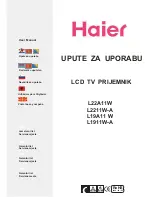
FCC ID: K66VX-2500V
Alignment
Vertex Standard Co., Ltd.
2/6
Frequency Counter with 0.1ppm accuracy at 1000MHz
AC Voltmeter
DC Voltmeter
VHF Sampling Coupler
IBM PC / compatible Computer
Oscilloscope
Vertex Standard VPL-1 Connection Cable & Alignment program
Alignment Preparation & Precautions
A 50-
Ω
RF Dummy Load and in-line wattmeter must be connected to the main antenna jack
in all procedures that call for transmission, except where specified otherwise. Correct
alignment is not possible with an antenna.
After completing one step, read the following step to determine whether the same test
equipment will be required. If not, remove the test equipment (except dummy load and
wattmeter, in connected) before proceeding.
Correct alignment requires that the ambient temperature be the same as that of the
transceiver and test equipment, and that this temperature be held constant between 20 and
30
°
C (68
∼
86
°
F). When the transceiver is brought into the shop from hot or cold air, it should
be allowed time to come to room temperature before alignment.
Whenever possible, alignments should be made with oscillator shields and circuit boards
firmly affixed in place.
Also, the test equipment must be thoroughly warmed up before beginning.
Note: Signal levels in dB referred to in the alignment procedure are based on
0dB
µ
EMF = 0.5
µ
V.
Setup the test equipment as shown for transceiver alignment,apply 13.8V DC power to the
transceiver. Refer to the drawings above for Alignment Points.
Fig.1 Alignment Setup
VPL-1
cable
J1502
Data port
VX-2500
In-Line
Wattmeter
RF sampling coupler
Deviation meter
Frequency
counter
50ohm
Dummy Load
13.8Vdc power supply
Signal generator
Antenna Port
Oscilloscope
AF
Generator
Sinad
Meter
4ohm
Dummy
Personal Computer
See Fig 2
























